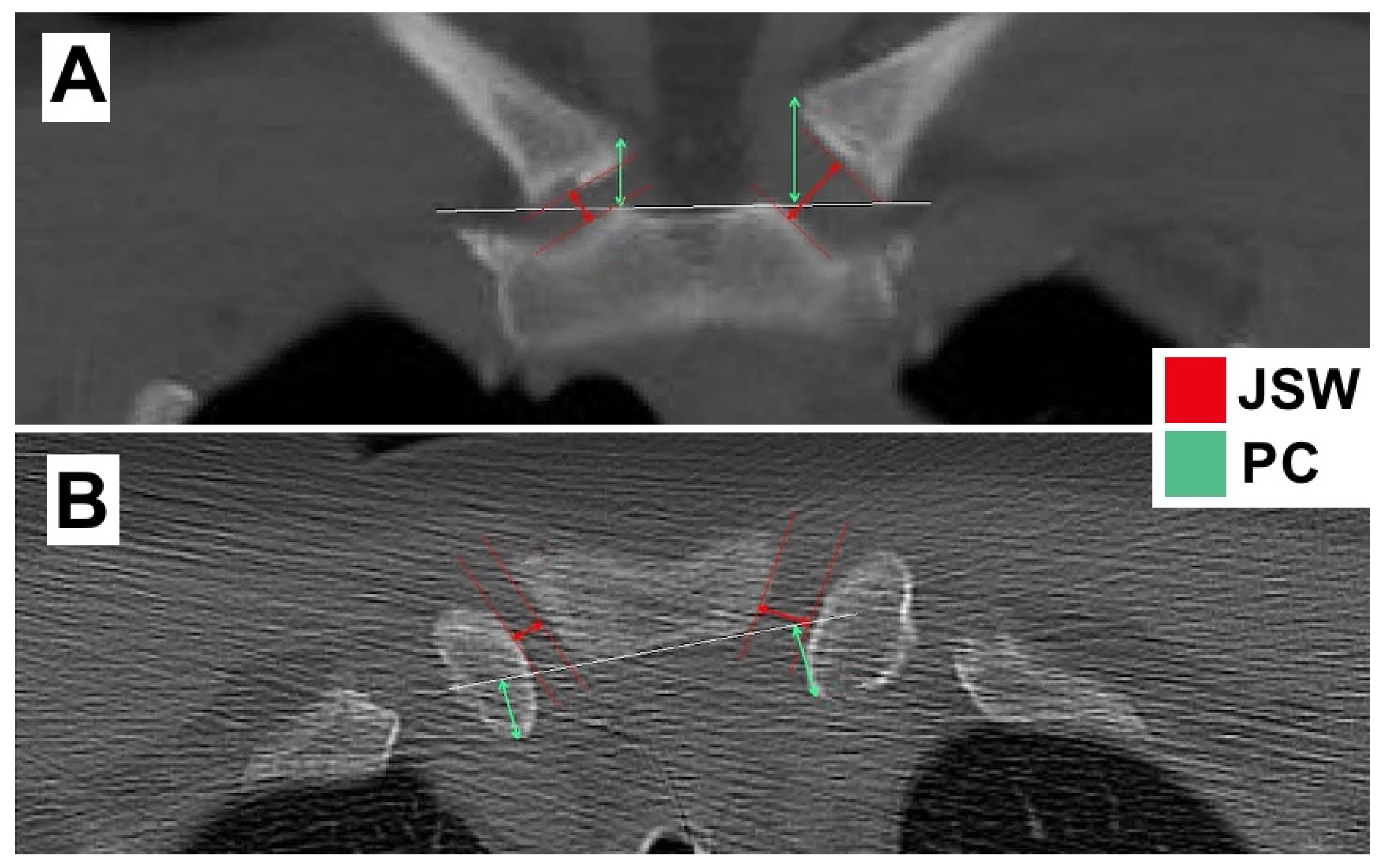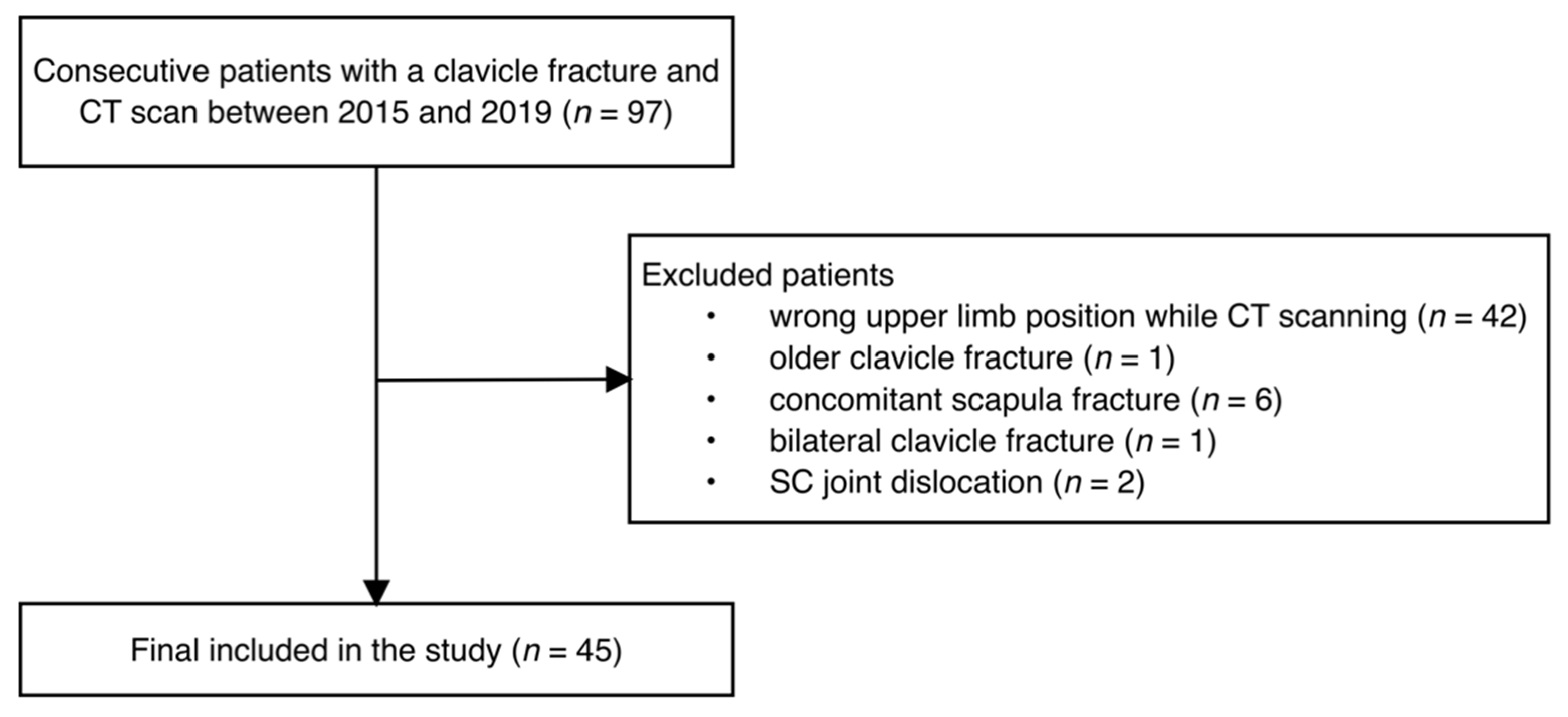Morphologic Alterations of the Sternoclavicular Joint following Ipsilateral Clavicle Fractures
Abstract
1. Introduction
2. Materials and Methods
2.1. Study Population
2.2. Radiological Evaluation
2.3. Statistical Methods
3. Results
3.1. Demographic Data
3.2. Clavicle Fractures
3.3. SCJ Morphology
4. Discussion
5. Conclusions
Author Contributions
Funding
Institutional Review Board Statement
Informed Consent Statement
Data Availability Statement
Conflicts of Interest
References
- Van Tongel, A.; De Wilde, L. Sternoclavicular joint injuries: A literature review. Muscles Ligaments Tendons J. 2011, 1, 100–105. [Google Scholar] [PubMed]
- Bakir, M.S.; Merschin, D.; Unterkofler, J.; Guembel, D.; Langenbach, A.; Ekkernkamp, A.; Schulz-Drost, S. Injuries of the Medial Clavicle: A Cohort Analysis in a Level-I-Trauma-Center. Concomitant Injuries. Management. Classification. Chirurgia 2017, 112, 594. [Google Scholar] [CrossRef] [PubMed]
- Garcia, J.A.; Arguello, A.M.; Momaya, A.M.; Ponce, B.A. Sternoclavicular Joint Instability: Symptoms, Diagnosis and Management. Orthop. Res. Rev. 2020, 12, 75–87. [Google Scholar]
- Kiel, J.; Kaiser, K. Sternoclavicular Joint Injury. In StatPearls; StatPearls: Treasure Island, FL, USA, 2020. [Google Scholar]
- Cave, E. Shoulder girdle injuries. In Fractures and Other Injuries; Year Book Publishers: Chicago, IL, USA, 1958; pp. 58–259. [Google Scholar]
- Morell, D.J.; Thyagarajan, D.S. Sternoclavicular joint dislocation and its management: A review of the literature. World J. Orthop. 2016, 7, 244–250. [Google Scholar] [CrossRef] [PubMed]
- Adamcik, S.; Ahler, M.; Gioutsos, K.; Schmid, R.A.; Kocher, G.J. Repair of sternoclavicular joint dislocations with FiberWire((R)). Arch. Orthop. Trauma Surg. 2017, 137, 341–345. [Google Scholar] [CrossRef]
- Sidhu, V.S.; Hermans, D.; Duckworth, D.G. The operative outcomes of displaced medial-end clavicle fractures. J. Shoulder Elb. Surg. 2015, 24, 1728–1734. [Google Scholar] [CrossRef]
- Ono, K.; Inagawa, H.; Kiyota, K.; Terada, T.; Suzuki, S.; Maekawa, K. Posterior dislocation of the sternoclavicular joint with obstruction of the innominate vein: Case report. J. Trauma 1998, 44, 381–383. [Google Scholar] [CrossRef]
- O’Connor, P.A.; Nolke, L.; O’Donnell, A.; Lingham, K.M. Retrosternal dislocation of the clavicle associated with a traumatic pneumothorax. Interact. Cardiovasc. Thorac. Surg. 2003, 2, 9–11. [Google Scholar] [CrossRef]
- Sanchez, G.; Kennedy, N.I.; Ferrari, M.B.; Chang, A.; Provencher, M.T. Sternoclavicular Joint Reconstruction in the Setting of Medial Comminuted Clavicle Fracture. Arthrosc. Tech. 2017, 6, e1355–e1359. [Google Scholar] [CrossRef][Green Version]
- Prasetia, R.; Rasyid, H.N. Bipolar fracture dislocation of clavicle: A report of osteosynthesis and early soft tissue reconstruction. Int. J. Surg. Case Rep. 2017, 41, 194–199. [Google Scholar] [CrossRef]
- Karl, J.W.; Olson, P.R.; Rosenwasser, M.P. The Epidemiology of Upper Extremity Fractures in the United States, 2009. J. Orthop. Trauma 2015, 29, e242–e244. [Google Scholar] [CrossRef] [PubMed]
- Neer, C.S. 2nd, Nonunion of the clavicle. J. Am. Med. Assoc. 1960, 172, 1006–1011. [Google Scholar] [CrossRef] [PubMed]
- Robinson, C.M. Fractures of the clavicle in the adult. Epidemiology and classification. J. Bone Jt. Surg. Br. 1998, 80, 476–484. [Google Scholar] [CrossRef]
- Allman, F.L., Jr. Fractures and ligamentous injuries of the clavicle and its articulation. J. Bone Jt. Surg. Am. 1967, 49, 774–784. [Google Scholar] [CrossRef]
- O’Neill, B.J.; Hirpara, K.M.; O’Briain, D.; McGarr, C.; Kaar, T.K. Clavicle fractures: A comparison of five classification systems and their relationship to treatment outcomes. Int. Orthop. 2011, 35, 909–914. [Google Scholar] [CrossRef]
- Gottschalk, H.P.; Browne Rh Fau-Starr, A.J.; Starr, A.J. Shoulder girdle: Patterns of trauma and associated injuries. J. Orthop. Trauma 2011, 25, 266–271. [Google Scholar] [CrossRef]
- Yadav, S.; Khanna, V.; Mukherjee, S. Ipsilateral sternoclavicular joint anterior dislocation with fracture of the mid shaft of the clavicle. J. Clin. Orthop. Trauma 2019, 10, 510–513. [Google Scholar] [CrossRef]
- Tompkins, M.; Bliss, J.; Villarreal, R.; Solga, P. Posterior sternoclavicular disruption with ipsilateral clavicle fracture in a nine-year-old hockey player. J. Orthop. Trauma 2010, 24, e36–e39. [Google Scholar] [CrossRef]
- Tanlin, Y. Ipsilateral sternoclavicular joint dislocation and clavicle fracture. J. Orthop. Trauma 1996, 10, 506–507. [Google Scholar] [CrossRef]
- Thomas, C.B., Jr.; Friedman, R.J. Ipsilateral sternoclavicular dislocation and clavicle fracture. J. Orthop. Trauma 1989, 3, 355–357. [Google Scholar] [CrossRef]
- Pearsall, A.W.T.; Russell, G.V., Jr. Ipsilateral clavicle fracture, sternoclavicular joint subluxation, and long thoracic nerve injury: An unusual constellation of injuries sustained during wrestling. Am. J. Sports Med. 2000, 28, 904–908. [Google Scholar] [CrossRef] [PubMed]
- Khalid, N.; Elbeshbeshy, A.; Alsaleh, K.A.; Al-Ahaideb, A. Anterior sternoclavicular dislocation associated with clavicular fracture: A case report and review of the literature. Eur. J. Orthop. Surg. Traumatol. 2013, 23, S179–S182. [Google Scholar] [CrossRef] [PubMed]
- Yanagawa, Y.; Ohsaka, H.; Jitsuiki, K.; Yoshizawa, T.; Takeuchi, I.; Omori, K.; Oode, Y.; Ishikawa, K. Vacuum phenomenon. Emerg. Radiol. 2016, 23, 377–382. [Google Scholar] [CrossRef]
- Patten, R.M.; Dobbins, J.; Gunberg, S.R. Gas in the sternoclavicular joints of patients with blunt chest trauma: Significance and frequency of CT findings. AJR Am. J. Roentgenol. 1999, 172, 1633–1635. [Google Scholar] [CrossRef] [PubMed]
- Shirazian, H.; Chang, E.Y.; Wolfson, T.; Gamst, A.C.; Chung, C.B.; Resnick, D.L. Prevalence of sternoclavicular joint calcium pyrophosphate dihydrate crystal deposition on computed tomography. Clin. Imaging 2014, 38, 380–383. [Google Scholar] [CrossRef] [PubMed]
- Salles, M.; Olive, A.; Perez-Andres, R.; Holgado, S.; Mateo, L.; Riera, E.; Tena, X. The SAPHO syndrome: A clinical and imaging study. Clin. Rheumatol. 2011, 30, 245–249. [Google Scholar] [CrossRef]
- Tuscano, D.; Banerjee, S.; Terk, M.R. Variations in normal sternoclavicular joints; a retrospective study to quantify SCJ asymmetry. Skelet. Radiol. 2009, 38, 997–1001. [Google Scholar] [CrossRef]
- De Maeseneer, M.; Lenchik, L.; Buls, N.; Boulet, C.; Doring, S.; de Mey, J.; Willekens, I. High-resolution CT of the sternoclavicular joint and first costochondral synchondrosis in asymptomatic individuals. Skelet. Radiol. 2016, 45, 1257–1262. [Google Scholar] [CrossRef]
- Cakmak, V.; Ozen, M. Sternoclavicular Joint Distances and Degenerative Changes in Computed Tomography. Cyprus J. Med Sci. 2021, 6, 136–140. [Google Scholar] [CrossRef]
- Hatfield, M.K.; Gross, B.H.; Glazer, G.M.; Martel, W. Computed tomography of the sternum and its articulations. Skelet. Radiol. 1984, 11, 197–203. [Google Scholar] [CrossRef]
- Kier, R.; Wain, S.L.; Apple, J.; Martinez, S. Osteoarthritis of the sternoclavicular joint. Radiographic features and pathologic correlation. Invest. Radiol. 1986, 21, 227–233. [Google Scholar] [CrossRef] [PubMed]
- Robinson, C.M.; Jenkins, P.J.; Markham, P.E.; Beggs, I. Disorders of the sternoclavicular joint. J. Bone Jt. Surg. Br. 2008, 90, 685–696. [Google Scholar] [CrossRef] [PubMed]
- Lawrence, C.R.; East, B.; Rashid, A.; Tytherleigh-Strong, G.M. The prevalence of osteoarthritis of the sternoclavicular joint on computed tomography. J. Shoulder Elb. Surg. 2017, 26, e18–e22. [Google Scholar] [CrossRef]
- Laffosse, J.M.; Espie, A.; Bonnevialle, N.; Mansat, P.; Tricoire, J.L.; Bonnevialle, P.; Chiron, P.; Puget, J. Posterior dislocation of the sternoclavicular joint and epiphyseal disruption of the medial clavicle with posterior displacement in sports participants. J. Bone Jt. Surg. Br. 2010, 92, 103–109. [Google Scholar] [CrossRef] [PubMed]
- Groh, G.I.; Wirth, M.A. Management of traumatic sternoclavicular joint injuries. J. Am. Acad. Orthop. Surg. 2011, 19, 1–7. [Google Scholar] [CrossRef]
- Gobet, R.; Meuli, M.; Altermatt, S.; Jenni, V.; Willi, U.V. Medial clavicular epiphysiolysis in children: The so-called sterno-clavicular dislocation. Emerg. Radiol. 2004, 10, 252–255. [Google Scholar] [CrossRef]


| Robinson Classification | n (%) |
|---|---|
| Medial | 4 (8.9) |
| 1A1 | - |
| 1A2 | 2 (4.4) |
| 1B1 | - |
| 1B2 | 2 (4.4) |
| Midshaft | 31 (68.9) |
| 2A1 | 8 (17.8) |
| 2A2 | 3 (6.7) |
| 2B1 | 11 (24.4) |
| 2B2 | 9 (20.0) |
| Lateral | 10 (22.2) |
| 3A1 | 3 (6.7) |
| 3A2 | - |
| 3B1 | 5 (11.1) |
| 3B2 | 2 (4.4) |
| Total | 45 |
| cJSW | aJSW | cPC | aPC | |
|---|---|---|---|---|
| Affected side in mm | 8.70 (4.30–15.50) | 8.98 (4.50–4.10) | 14.31 (5.50–31.30) | 9.40 (2.20–14.40) |
| Non-affected side in mm | 7.63 (3.40–13.40) | 8.32 (4.10–13.20) | 13.49 (4.90–22.40) | 9.02 (1.00–9.02) |
| Mean difference in mm | 1.07 (1.67) | 0.67 (2.02) | 0.83 (2.07) | 0.38 (2.20) |
| Mean difference in % | 14.02 m | 7.93 m | 6.08 m | 4.02 m |
| p-value | <0.001 | 0.044 | 0.011 | 0.274 |
| Difference of Affected vs. Non-Affected Side for | Clavicle Fracture Location | p-Value | ||
|---|---|---|---|---|
| Medial (n = 4) | Midshaft (n = 31) | Lateral (n = 10) | ||
| cJSW | 3.30 ± 1.37 | 1.31 ± 1.36 | 1.63 ± 0.96 | 0.048 |
| aJSW | 3.17 ± 2.74 | 1.32 ± 1.41 | 1.61 ± 1.30 | 0.547 |
| cPC | 1.34 ± 0.89 | 1.72 ± 1.19 | 2.10 ± 2.09 | 0.884 |
| aPC | 0.40 ± 0.35 | 1.9 ± 1.77 | 1.31 ± 1.44 | 0.547 |
Publisher’s Note: MDPI stays neutral with regard to jurisdictional claims in published maps and institutional affiliations. |
© 2022 by the authors. Licensee MDPI, Basel, Switzerland. This article is an open access article distributed under the terms and conditions of the Creative Commons Attribution (CC BY) license (https://creativecommons.org/licenses/by/4.0/).
Share and Cite
Jessen, M.; Schnetzke, M.; Studier-Fischer, S.; Grützner, P.A.; Gühring, T.; Porschke, F. Morphologic Alterations of the Sternoclavicular Joint following Ipsilateral Clavicle Fractures. Int. J. Environ. Res. Public Health 2022, 19, 15011. https://doi.org/10.3390/ijerph192215011
Jessen M, Schnetzke M, Studier-Fischer S, Grützner PA, Gühring T, Porschke F. Morphologic Alterations of the Sternoclavicular Joint following Ipsilateral Clavicle Fractures. International Journal of Environmental Research and Public Health. 2022; 19(22):15011. https://doi.org/10.3390/ijerph192215011
Chicago/Turabian StyleJessen, Malik, Marc Schnetzke, Stefan Studier-Fischer, Paul Alfred Grützner, Thorsten Gühring, and Felix Porschke. 2022. "Morphologic Alterations of the Sternoclavicular Joint following Ipsilateral Clavicle Fractures" International Journal of Environmental Research and Public Health 19, no. 22: 15011. https://doi.org/10.3390/ijerph192215011
APA StyleJessen, M., Schnetzke, M., Studier-Fischer, S., Grützner, P. A., Gühring, T., & Porschke, F. (2022). Morphologic Alterations of the Sternoclavicular Joint following Ipsilateral Clavicle Fractures. International Journal of Environmental Research and Public Health, 19(22), 15011. https://doi.org/10.3390/ijerph192215011







